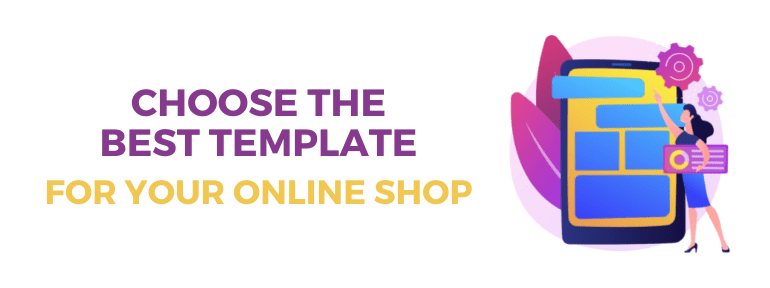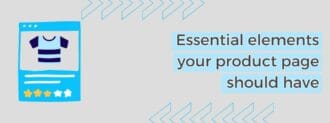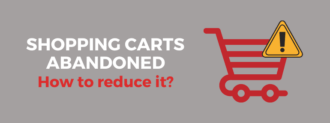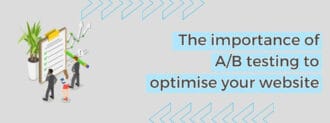First impressions count. How many times have you heard this? Well, it also applies to e-commerce. That’s why choosing the right template for your online store it’s very important. Think about it: if you’re looking for a product X, you come to a store that looks terrible, and then to another one that has an excellent image: in which one are you going to buy? Well, that’s it.
Table of contents
What should the perfect template for my online store have?
The most obvious thing we can tell you is that the style of the template you decide on should go hand in hand with the idea you have of the look and personality of your online business: sober, fun, vintage, colorful, etc.

The second thing to be clear about is the functionalities. For example, your e-commerce has three pillars, and each one has different needs. Therefore, when you’re checking out a template demo, if you aren’t going to have the budget to customize it, make sure that the design and functionalities meet the following requirements about these three pillars:
Home page
This is going to be, in many cases, the first impression we were talking about, because it will be, almost 100% sure, the most linked page from other sites. Make it worthwhile.
- The information has to be clear, ordered, with visible and well-directed links to the other places in the online store that you’re interested in linking to.
- The template should include icons that direct to social networks. We advise you to have profiles on the most important social networks, and to post there the news of your online store, talk about your best products and most of all, talk to your customers (current or potential ones) to create engagement.
- The menu should be clear, with all the sub-categories of the e-commerce available from the main categories, for easy access.
- The template should have the option to add photos of featured products, new products, best sellers… as this will be the first thing you want users to see.
Category page
Like the home page, it needs to be clear and organized. When someone searches for some of your products on the Internet, this is where they will land the greatest part of the times, as it should be what is best positioned in search engines.
- You’ll probably have many products in the categories: make it easy for the user to find the one they are looking for, thanks to a template that incorporates a filter by brand, color, price, etc.
- Make sure that the photos of the products are large and are very well highlighted.
Product page
In this case, the first impression has already been achieved (few people will come directly to your product by searching on the Internet, it will be more through the category). This doesn’t mean that you shouldn’t take care of the product page of your store.
Check that the product page template contains all these elements:
- Product name.
- Product price clearly visible.
- Description (possibility of including two: a brief and a more detailed one)
- Product reference (if they have to write you an email referring to the product, it will always be better if they give you a reference, than if they tell you “the blue short sleeve t-shirt”)
- Possibility for customers to leave reviews.
- Option to show related products to add to the basket.
- Product filters by size, colour…
- And it never hurts that even here, the template also includes sharing on social networks.

What should I look for before buying an e-commerce template?
There are many things. Let’s go through them.
The platforms for the purchase of templates should be transparent in data such as the number of downloads of each template, the ratings of users who have already implemented them in their online store… And above all, make it very clear with which version of PrestaShop (1.6 or 1.7) is compatible, and whether there’s any difference when installing it in one or the other.
Of course, whatever template you choose, it has to be responsive and adapted to mobile, tablet and desktop equally.
And if you’re not very skilled in all these issues about templates and their installation, make sure there’s a technical support department to back you up and help you when you need it. There’s no point in buying the coolest PrestaShop template on the planet, if you don’t know how to install it or use it to exploit its full performance in your online store.
For example, if, as we talked about in the previous point, you have to adapt the template to the colors, logo and personality of your brand, make sure you can do it!
The latter is the most important thing: the template’s functionalities. By this we mean features like the following:
- Navigation, such as the cart always visible, with a search block…
- Design, such as zoom in the product image, selection of the number of columns…
- Technology, such as including Rich Snippets for Google, progressive loading of images…
- Or functionalities in the menu, which can be vertical, or drop-down, etc…
And many more. We’re talking about this topic in the next section.
Where to get your PrestaShop template
We know that there are free templates. But we also believe that, since you’re setting up a business, it’s better to do it with the best resources. Also, it’s very important that you differentiate yourself from others by using a design that’s worthwhile.
That said, free templates, although visually “cool”, might have limitations regarding the backoffice that the paid ones don’t have. And believe me, if your business is going well and in the future it turns out that you have to use another template that actually meets your needs, you’re going to have to spend money for a professional to do it for you.
Therefore, if you’re looking for a template for your online store, go to the PrestaShop Addons Themes Store, where you can buy a template from 59€. You can choose template by themes (art, gifts, drinks, health…), styles (minimalist, original…), customer ratings…
And very important, each template has a detailed list of all the features it includes – which is where many of the free ones can fail, and the template features will play a big role in whether your online store prospers or not. Also, with the paid ones, you can even contact the developer if you have any doubts.
Let’s say it this way: a store that already includes electricity, water, air conditioning, waiting rooms, cash register, etc. is not the same than a place that only has electricity, water and little more. Right?
We’re very insistent on this subject, yes, but based on our experience with more than 500 customers, this is what we feel obliged to tell you: if you want to set up a professional business, with a prospects of growth and prosperity, invest in a PrestaShop template
Also, remember what we told you earlier about support? These PrestaShop store themes include 3 months of free support.

Improve the SEO of your online store template
That said, and without wanting to belittle anyone, many of the templates (if not all, even paid ones), have been designed with that in mind: the design, the look and feel. But they’re not optimized for technical SEO (even if they indicate that they are optimized for SEO)
So we’re telling you right now: for your online store to work 100%, you’re going to need to tweak certain SEO elements in the template, such as the following:
- The URLs are not friendly (and this is fundamental)
- The Google robot is left to index all the URL variations of the same page, which result automatically when searching in the store or filtering products.
- Title hierarchies (the index in which you tell Google what is most important on your page) aren’t built correctly automatically. In many cases the H1, which is essential, is even left empty.
- Many links that should be no follow (i.e. that Google is asked to ignore) in the template are automatically set as follow (i.e. Google is asked to take them into account for its index)
And so, a few more things.
As in Innovadeluxe we also have an SEO department, our customers, whether they build the online store with us or bring one already made, end up having a store optimized in every way: design and SEO. Which is the best solution, in our book.
Conclusion
No one likes to be in a restaurant that overwhelms, in a clothing store without order, or browse and buy in an online store where nothing is clear. So keep in mind your type of business and its personality to choose the right template.
And above all, don’t forget about the “back room”. It’s not only important what the customer sees or perceives, but also that the store works optimally: functionalities, technical support and SEO optimization. For the latter, remember that you can always contact us and ask us for an SEO audit to solve all those bugs that come by default with your PrestaShop template. Or even ask us for a custom template.
Otherwise, we hope we have helped you. If you have any questions, feel free to write us in the comments!
Related Posts










Deja un comentario